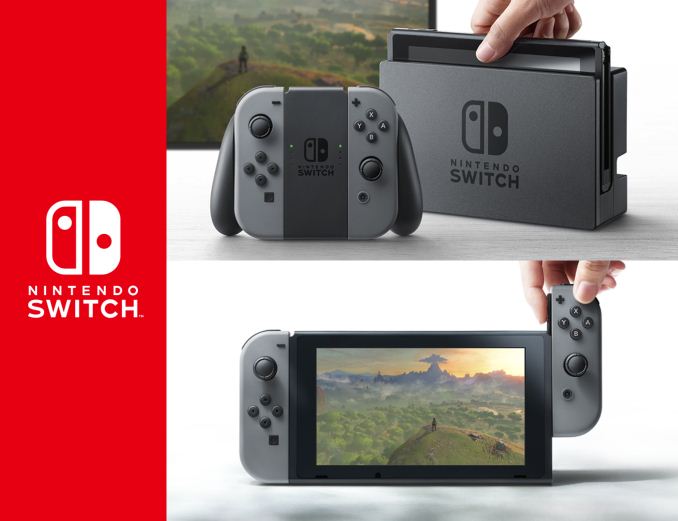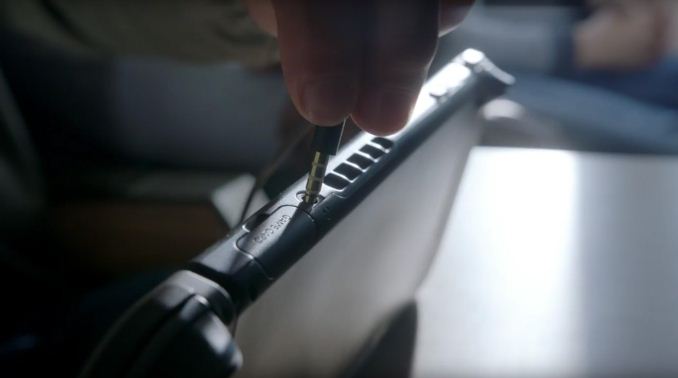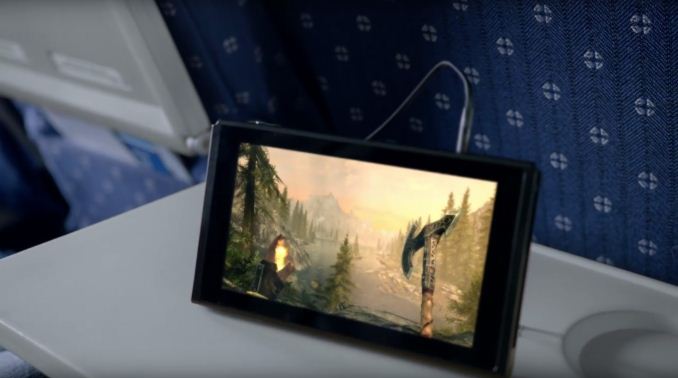Nintendo Announces Switch Portable Gaming Console - Powered by NVIDIA Tegra
by Ryan Smith on October 20, 2016 4:25 PM EST
Earlier today Nintendo took the wraps off of their next generation console, Switch. Formerly known by the codename NX, the Switch is the successor to both Nintendo’s portable DS and set top Wii console lines, utilizing a portable, tablet-like unit that can be docked to behave like a set top console. Today’s announcement, in the form of a 3 minute trailer, is meant to tease the console ahead of its full launch in March of 2017.
While I’ll skip the commentary on the console’s unusual design – dedicated gaming sites can offer better context – I wanted to dive into the hardware in the Switch. Given that this was a teaser, I was not expecting a reveal of any of the hardware specifications of the console, and indeed neither Nintendo’s teaser video nor their related press release made any mention of the underlying hardware. However shortly after the reveal went live, NVIDIA sent out an email to the press and posted a blog of their own. As it turns out, while today is still just a teaser, in some ways we’re already getting more information about the console than in any previous generation of Nintendo’s hardware.
In their blog post, NVIDIA confirmed that they would be providing the underlying SoC for the console. As this is still ultimately a teaser, NVIDIA’s own details are light, but their announcement confirms that it’s a custom version of their Tegra SoC. Curiously, no mention of the CPU core in that SoC is mentioned. However as it’s a Tegra, something ARM-based is the logical (if not only) choice. And on the GPU side, as you’d expect, they’re using a GPU based on one of NVIDIA’s existing GPU architectures, though the company isn’t specifying if it’s Pascal or Maxwell (I’d assume Pascal, but consoles are known for their long development cycles).
Otherwise, as far as specifications go that’s all we get for now. Though as NVIDIA is supplying a whole SoC there are obviously many more parts to the package that we’ll hopefully learn about in the near future. More CPU and GPU details are obviously the most interesting aspect – does the Switch SoC use Denver CPU cores? – but there’s also the matter of memory bandwidth, WiFi support, and the many other functional blocks that make up an SoC.
For NVIDIA, this is the first console hardware win for the company since the PlayStation 3, which launched in 2006. In the set top console market, AMD has since provided the GPU (and often, the CPU) for the most recent generation of consoles. Otherwise NVIDIA has never had a 3rd party portable console win, primarily because both Nintendo and Sony developed their respective SoCs internally for the 3DS and Vita.
In fact, given that Nintendo previously did much of their portable console development work internally, this is a notable shift for how the company operates. The 3DS was essentially a custom SoC combining multiple ARM11 (ARMv6) CPU cores with an OpenGL ES 1.1 generation GPU from the little-known Digital Media Professionals (DMP). So this is the first time Nintendo has contracted out their SoC needs to a third party in such a visible fashion. I’m actually a bit surprised that NVIDIA is even allowed to talk about their involvement at this point in time, given Nintendo’s historical focus on secrecy.
Though all of this also helps to underline just how big a jump in technology the Switch is from the 3DS. On the CPU side alone it’s reasonable to assume we’re looking at CPU design in the neighborhood of 4.x DMIPS/MHz, versus ARM11’s approximate 1.3 DIMPS/MHz rate, so IPC will have increased significantly, never mind an increase in frequency. Meanwhile on the GPU side, Nintendo is going from a GPU that didn’t even have a programmable GPU pipeline (i.e. shaders) to a fully modern GPU, essentially catching up on a decade of mobile GPU development in a single bound. Given that the console has to work as both the company’s portable and set top consoles, Nintendo has opted to use far more modern tech than their traditionally conservative designs.
Finally, without reading too much into a 5 paragraph announcement, there is one other interesting nugget of information in NVIDIA’s blog post that further shows just how deep the NVIDIA/Nintendo relationship is going here. Along with providing the SoC, NVIDIA also has a major stake in the development of the console’s API and middleware. While NVIDIA presumably isn’t developing the entire software stack, they make special note of the fact that they are providing a new “lightweight” API, NVN, for the console. NVIDIA is also providing middleware in the form of “a revamped physics engine, new libraries, advanced game tools and libraries” and “custom software for audio effects and rendering” which sounds a great deal like NVIDIA having brought over major parts of their GameWorks SDK, including the PhysX physics simulation libraries and VRWorks Audio library.
In any case, it will be interesting to see how this plays out over the next few months. The mobile world has changed significantly since the 3DS was launched in 2011, something that the Switch’s design makes obvious. Nintendo has gone in a very different direction than either their console rivals or the smartphone market that is always threatening to encroach on mobile consoles, and that’s reflected in both the unusual dual-mode console and the hardware inside of it.












109 Comments
View All Comments
Wolfpup - Friday, October 21, 2016 - link
Denver isn't actually ARM is it? It's ARM compatible through software, and was going to support x86 too, only they couldn't get a license? (Which stinks, as they'd be great for some mid-range Windows tablets that could even play games!)Obviously I want a "Gamecube 2" that competes with Scorpio (SP?) in specs, but given Nintendo gave up on "big" consoles a decade ago, this is probably the next best thing. They get to consolidate their development on a single system, making even just their 1st party games go a lot further. 3DS managed to do quite well against iOS and Android devices, and it was underpowered at launch, while this should be basically state of the art for a mobile device.
AND the ability to hook it up to a TV is cool...I wanted that for Vita and 3DS!
If, like me, you like a good chunk of Nintendo's output, having to buy just a single console, and having it be a high-end portable doesn't sound too bad at all.
barleyguy - Friday, October 21, 2016 - link
Denver is 64-bit ARM, though internally it's a micro-op core. Much like modern x86 processors it has a decoder layer at the front end which decodes to micro-ops in the execution units.NVidia isn't allowed to make x86 processors, AFAIK. They settled a lawsuit against Intel regarding x86 chipsets in 2011, and they agreed not to make x86 chipsets or processors.
http://www.anandtech.com/show/4122/intel-settles-w...
CannedTurkey - Friday, October 21, 2016 - link
The only thing I haven't seen is them dropping the switch into some goggles and turning it into VR.barleyguy - Friday, October 21, 2016 - link
That would actually be really cool. It would be like Samsung Gear except dedicated gaming hardware.Though VR gaming at less than 90 fps has been known to make people ill, and I doubt that the screen does 90 fps.
wolfemane - Tuesday, October 25, 2016 - link
I'm a little late to this party, but I wanted to comment.I could see getting excited about this. But it will suffer the same issue that the previous generation Nintendo consoles have suffered. A giant lack of content. We will see the same refresh of Zelda, Mario cart, Smash Bro's, pokemon, and a handful of Nintendo only titles. That alone will kill this for me.
I think Nintendo is on the right track, but they need to expand their content... a lot. Until I see a game list and future titles, it looks like this consumer might be passing on yet another Nintendo gimmick,
zodiacfml - Tuesday, October 25, 2016 - link
Nvidia Shield to me.damianrobertjones - Tuesday, October 25, 2016 - link
"tease the console ahead of its full launch in March of 2017."Wow cool I can then play this on Chris.... Oh it's March 2017. Oh well. Oopss :/
damianrobertjones - Tuesday, October 25, 2016 - link
P.s. Will still buy it in two years time when the console is around £140 new along with all the games being £6.Einy0 - Tuesday, October 25, 2016 - link
Great concept but MAR 2017 for an underpowered hybrid console, FAIL!!!